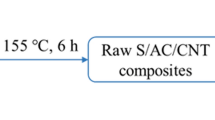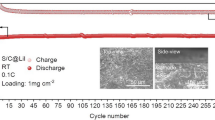Abstract
Lithium–sulfur batteries are a potential choice for future energy storage due to their low cost, abundant resources, non-toxicity, and environmental friendliness. However, problems such as insufficient battery conductivity, volume expansion, and shuttle effect constrain their further development. In this study, carbon nanotubes (CNTs) were composited with NiCoO2−x, an oxygen vacancy bimetallic oxide with excellent electrochemical properties, as cathode materials for lithium–sulfur batteries. The experiment result shows that the NiCoO2−x/CNTs composite material outperformed pure CNTs. At a 0.1 C rate, the discharge specific capacity of the composite was 1289.9 mAh/g, with an active material utilization of 77%, compared to 881.9 mAh/g and 52.65% for pure CNTs. The composite material exhibited excellent rate performance, maintaining a high discharge specific capacity even at higher rates. Long-term cycling tests revealed a capacity retention of 74.68% after 200 cycles for the composite material, compared to significantly lower retention for CNTs. This study provides new ideas for the study of lithium–sulfur batteries.






Similar content being viewed by others
Data availability
The authors declare that data supporting the finding of this study are available within the article.
References
R. Razaq, D. Sun, Y. Xin et al., Enhanced kinetics of polysulfide redox reactions on Mo2C/CNT in lithium–sulfur batteries. Nanotechnology 29(29), 295401 (2018)
X. Jia, B. Liu, J. Liu et al., Fabrication of NiO–carbon nanotube/sulfur composites for lithium–sulfur battery application. RSC Adv. 11(18), 10753–10759 (2021)
M.H. Esfahani, S. Zinatloo-Ajabshir, H. Naji et al., Structural characterization, phase analysis and electrochemical hydrogen storage studies on new pyrochlore SmRETi2O7 (RE = Dy, Ho, and Yb) microstructures. Ceram. Int. 49(1), 253–263 (2023)
M. Ghodrati, M. Mousavi-Kamazani, S. Zinatloo-Ajabshir, Zn3V3O8 nanostructures: facile hydrothermal/solvothermal synthesis, characterization, and electrochemical hydrogen storage. Ceram. Int. 46(18), 28894–28902 (2020)
S. Zinatloo-Ajabshir, Z. Salehi, O. Amiri et al., Simple fabrication of Pr2Ce2O7 nanostructures via a new and eco-friendly route; a potential electrochemical hydrogen storage material. J. Alloys Compd. 791, 792–799 (2019)
S. Zinatloo-Ajabshir, M.S. Morassaei, O. Amiri et al., Nd2Sn2O7 nanostructures: green synthesis and characterization using date palm extract, a potential electrochemical hydrogen storage material. Ceram. Int. 46(11), 17186–17196 (2020)
L. Yan, Z. Zhang, F. Yu et al., Rational design of NiCo2S4@ MoS2 ball-in-ball heterostructure nanospheres for advanced lithium–sulfur batteries. Electrochem. Acta 383, 138268 (2021)
G. Zhou, L. Li, Q. Zhang et al., Octahedral Co3O4 particles threaded by carbon nanotube arrays as integrated structure anodes for lithium ion batteries. Phys. Chem. Chem. Phys. 15(15), 5582–5587 (2013)
Z. Jian, S. Zhang, X. Guan et al., ZnO quantum dot-modified rGO with enhanced electrochemical performance for lithium–sulfur batteries. RSC Adv. 10(54), 32966–32975 (2020)
M. Li, W. Feng, W. Su et al., CoNi-embedded nitrogen-enriched porous carbon framework for long-life lithium–sulfur batteries. J. Solid State Electrochem. 23, 2317–2324 (2019)
P. Zeng, H. Yu, M. Chen et al., Flower-like ZnO modified with BiOI nanoparticles as adsorption/catalytic bifunctional hosts for lithium–sulfur batteries. J. Energy Chem. 51, 21–29 (2020)
M. Zhen, S.Q. Guo, B. Shen, Constructing defect-rich MoS2/N-doped carbon nanosheets for catalytic polysulfide conversion in lithium–sulfur batteries. ACS Sustain. Chem. Eng. 8(35), 13318–13327 (2020)
N. Nakamura, S. Ahn, T. Momma et al., Future potential for lithium–sulfur batteries. J. Power Sources 558, 232566 (2023)
X. Xia, Hollow NiCo2O4 nanocages as sulfur host for advanced lithium–sulfur batteries. Mater. Res. Express 6(9), 095309 (2019)
J. Yu, K. Shi, S. Zhang et al., A lithium nucleation-diffusion-growth mechanism to govern the horizontal deposition of lithium metal anode. Sci. China Mater. 64(10), 2409–2420 (2021)
S. Zinatloo-Ajabshir, M.S. Morassaei, M. Salavati-Niasari, Eco-friendly synthesis of Nd2Sn2O7–based nanostructure materials using grape juice as green fuel as photocatalyst for the degradation of erythrosine. Compos. Part B: Eng. 167, 643–653 (2019)
S. Zinatloo-Ajabshir, Z. Salehi, M. Salavati-Niasari, Synthesis of dysprosium cerate nanostructures using phoenix dactylifera extract as novel green fuel and investigation of their electrochemical hydrogen storage and coulombic efficiency. J. Clean. Prod. 215, 480–487 (2019)
S. Zinatloo-Ajabshir, M. Salavati-Niasari, Preparation of magnetically retrievable CoFe2O4@ SiO2@ Dy2Ce2O7 nanocomposites as novel photocatalyst for highly efficient degradation of organic contaminants. Compos. Part B: Eng. 174, 106930 (2019)
M. Rezayeenik, M. Mousavi-Kamazani, S. Zinatloo-Ajabshir, CeVO4/rGO nanocomposite: facile hydrothermal synthesis, characterization, and electrochemical hydrogen storage. Appl. Phys. A 129(1), 47 (2023)
M. Mousavi-Kamazani, S. Zinatloo-Ajabshir, M. Ghodrati, One-step sonochemical synthesis of Zn(OH)2/ZnV3O8 nanostructures as a potent material in electrochemical hydrogen storage. J. Mater. Sci.: Mater. Electron. 31, 17332–17338 (2020)
K. Zou, X. Chen, W. Jing et al., Facilitating catalytic activity of indium oxide in lithium–sulfur batteries by controlling oxygen vacancies. Energy Storage Mater. 48, 133–144 (2022)
L. Xu, H. Zhao, M. Sun et al., Oxygen vacancies on layered niobic acid that weaken the catalytic conversion of polysulfides in lithium–sulfur batteries. Angew. Chem. 131(33), 11615–11620 (2019)
J. Chen, W. Feng, W. Zhao et al., Transition metal phosphide composite with metal-organic framework and carbon nanotubes for high-performance lithium–sulfur batteries. J. Alloys Compd. 890, 161794 (2022)
T. Han, M. Luo, Y. Liu et al., Sb2S3/Sb2Se3 heterojunction for high-performance photodetection and hydrogen production. J. Colloid Interface Sci. 628, 886–895 (2022)
Y. Ma, M. Wu, X. Jin et al., (NH4) 2V7O16 microbricks as a novel anode for aqueous lithium-ion battery with good cyclability. Chemistry–A Eur. J. 27(48), 12341–12351 (2021)
X. Xu, B. Dong, S. Ding et al., Hierarchical NiCoO2 nanosheets supported on amorphous carbon nanotubes for high-capacity lithium-ion batteries with a long cycle life. J. Mater. Chem. A 2(32), 13069–13074 (2014)
Y. Li, Z. Zhou, G. Cheng et al., Flower-like NiCo2O4–CN as efficient bifunctional electrocatalyst for Zn-air battery. Electrochim. Acta 341, 135997 (2020)
L. Zhao, K. Wang, W. Wei et al., High-performance flexible sensing devices based on polyaniline/MXene nanocomposites. InfoMat 1(3), 407–416 (2019)
Y. Yuan, D. Long, Z. Li et al., Fe substitution in urchin-like NiCo2O4 for energy storage devices. RSC Adv. 9(13), 7210–7217 (2019)
P. Wang, C. Li, S. Dong et al., Hierarchical NiCo2S4@ NiO core–shell heterostructures as catalytic cathode for long-life Li–O2 batteries. Adv. Energy Mater. 9(24), 1900788 (2019)
S. Feng, J. Wang, N. Gao et al., Heterogeneous interface of Ni–Mn composite prussian blue analog-coated structure modulates the adsorption and conversion of polysulfides in lithium–sulfur batteries. Electrochim. Acta 433, 141218 (2022)
Y. Huang, D. Lv, Z. Zhang et al., Co-fe bimetallic sulfide with robust chemical adsorption and catalytic activity for polysulfides in lithium–sulfur batteries. Chem. Eng. J. 387, 124122 (2020)
W. Wang, Y. Zhao, Y. Zhang et al., Defect-rich multishelled Fe-doped Co3O4 hollow microspheres with multiple spatial confinements to facilitate catalytic conversion of polysulfides for high-performance Li–S batteries. ACS Appl. Mater. Interfaces 12(11), 12763–12773 (2020)
Y. Zhang, S. Yao, R. Zhuang et al., Shape-controlled synthesis of Ti4O7 nanostructures under solvothermal-assisted heat treatment and its application in lithium–sulfur batteries. J. Alloys Compd. 729, 1136–1144 (2017)
Acknowledgements
HongLiu First-class Disciplines Development Program of Lanzhou University of Technology.
Funding
This work was financially supported by the National Natural Science Foundation of China (Grant No.21965019).
Author information
Authors and Affiliations
Contributions
WH: data curation, writing—original draft preparation. WF: writing—review. YN: software, data curation.
Corresponding author
Ethics declarations
Conflict of interest
The authors declare that there are no known competing financial interests or personal relationships that influence the work reported in this article.
Additional information
Publisher’s Note
Springer nature remains neutral with regard to jurisdictional claims in published maps and institutional affiliations.
Rights and permissions
Springer Nature or its licensor (e.g. a society or other partner) holds exclusive rights to this article under a publishing agreement with the author(s) or other rightsholder(s); author self-archiving of the accepted manuscript version of this article is solely governed by the terms of such publishing agreement and applicable law.
About this article
Cite this article
Hu, W., Feng, W., Niu, Y. et al. Effect of NiCoO2−x–CNTs/S cathode on electrochemical performance of Lithium–sulfur batteries. J Mater Sci: Mater Electron 34, 2145 (2023). https://doi.org/10.1007/s10854-023-11458-8
Received:
Accepted:
Published:
DOI: https://doi.org/10.1007/s10854-023-11458-8




